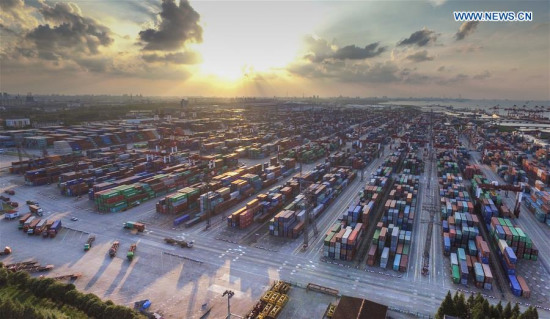
Aerial photo taken on Sept. 19, 2015 shows the Waigaoqiao container pier of the Shanghai free trade zone (FTZ) in Shanghai, east China. (Photo: Xinhua/Pei Xin)
Mixed signals seem to be obscuring China's economic outlook.
Foreign trade, a traditional engine of growth, ended 2015 with its first annual contraction in six years. Investment, another engine, also faltered, dragged down by a property market downturn and industrial overcapacity. Signs of economic stress are emerging: capital is leaving the country, bad debt is rising and financial market volatility is dampening confidence.
Yet that is not the full story. China's economy also has impressive underlying strengths, and policy makers have the determination to fix structural problems while containing risks.
Economists forecast growth will continue to decline. "It will be in an L-shape trajectory for a while," said Liu Shijin, former deputy director of China's State Council Development Research Center. "But that will be a process of transformation and rebalancing."
CAUSE OF CONCERN
A stimulus package, while helping lift China's economy out of the mire of the global financial crisis, also fueled over-investment and over-building nationwide, leading to industrial overcapacity and a surplus in property supply that turned the manufacturing and property sectors from drivers to drags on growth, economists said.
Many economists, including State Information Center economist Zhu Baoliang, Bank of Communications chief economist Lian Ping and Zhong Zhengsheng, an economist with Caixin Insight Group, all labeled the property sector the biggest threat to the economy.
Growth of property investment, which used to account for about one-fifth of China's total investment and affects more than 40 other industries ranging from steel and cement to furniture, continued to decline. It fell to only 1.3 percent for the January-November period from the double-digit rises regularly reported until 2014.
Zhu expected property investment to register its first annual decrease this year, the first time in over a decade, as property development remained constrained by property developers' excess property inventories, which he estimated at 150 million units.
Despite stagnating economic growth, sustained poor performance of the property sector could breed financial risks, Zhong Zhengsheng warned.
Another major concern lies in the industrial sector, which is awash with excess capacity that is driving down profits and threatens to further destabilize the already slowing growth.
Industrial overcapacity is not a new problem, but it was exacerbated by the 2009 stimulus package and continued to worsen despite the government's efforts to curtail it in recent years.
China's industrial output growth slowed to 6.2 percent in November, a slight rebound from October, from the double-digit rates regularly recorded previously.


















































